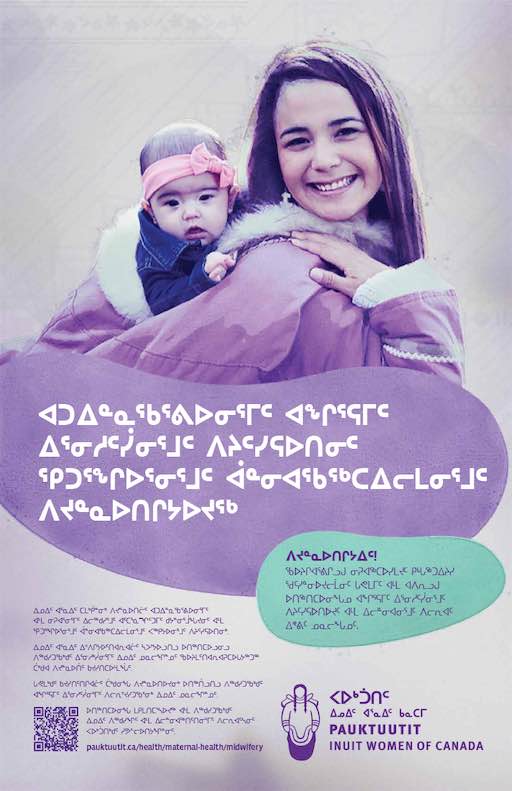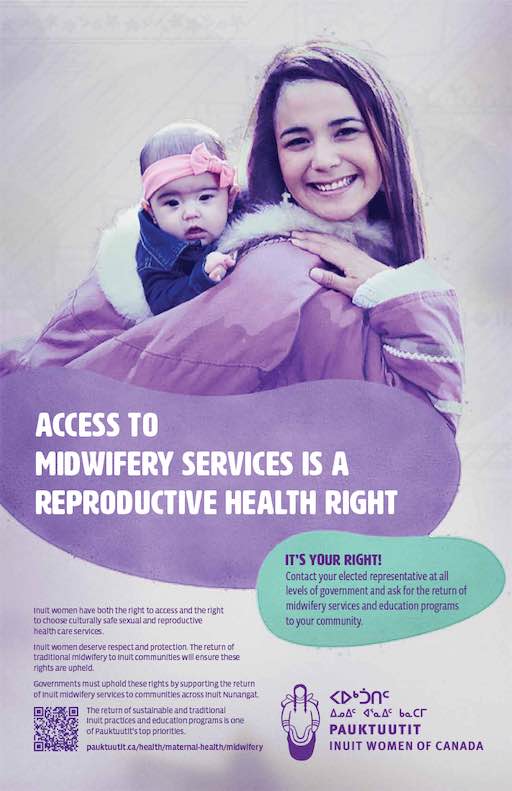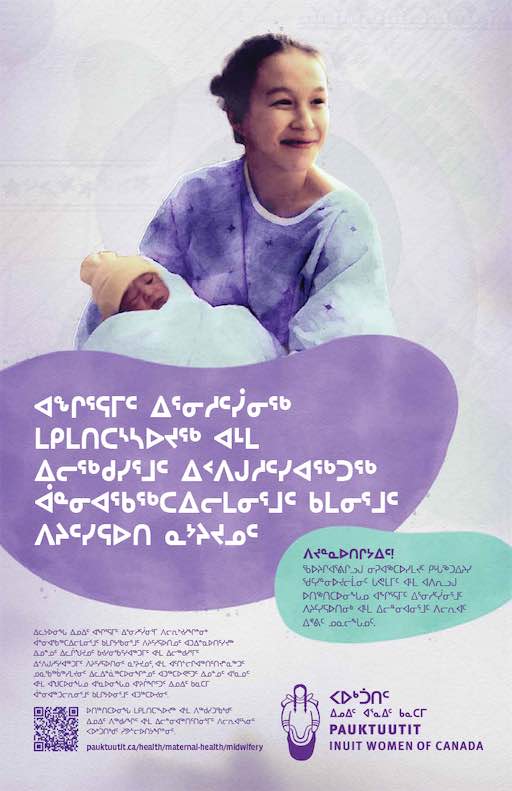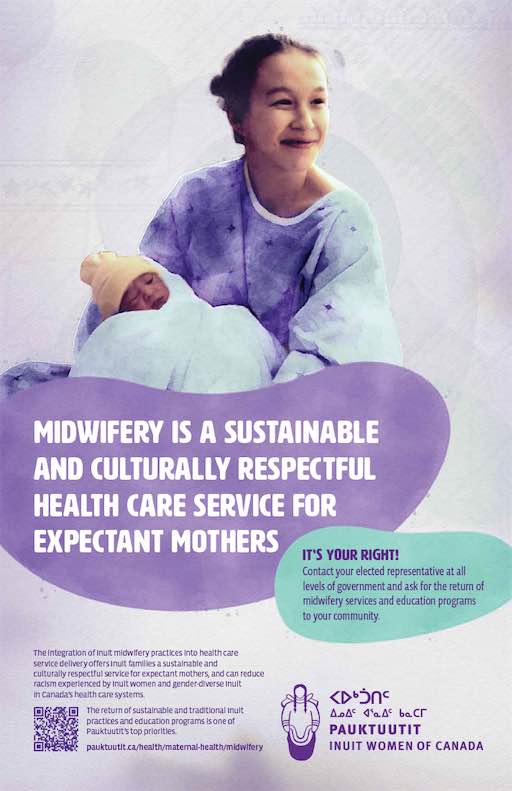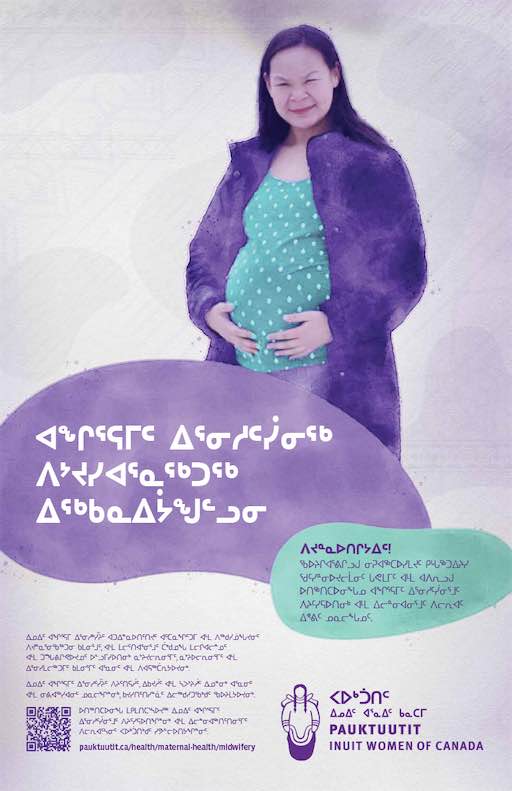
The bonds within families and communities were reinforced and intensified beyond childbirth. The bonds extended to a child’s education and roles in communities. Children had a special bond with the person who delivered them, especially if the person was a grandparent.
Inuk children were taught to show appreciation and respect to the person who helped bring them into the world. For example, it was customary to present one’s midwife with the child’s first piece of sewing or the first animal hunted. This expression of gratitude would maintain and reinforce the relationship throughout the child’s life.
Starting in the 1950’s, Inuit were ‘encouraged’ to move into communities by the federal government through the provision of family benefits and health services. During this time, government regulations also led to limited opportunities for Inuit women to practice midwifery. Home births and Inuit midwifery were actively discouraged, and women were forced to give birth at the nursing station.
Over time, medical authorities began evacuating pregnant women considered high risk to hospitals. The evacuation has evolved into present day practice and almost all Inuit women are forced to leave their home communities to give birth in regional hospitals of southern medical centers.
Currently, Inuit women’s sexual and reproductive health is compromised by regulatory limitations that are neither trauma-informed nor culturally appropriate for Inuit. The regulatory limitations are evident by the disproportionate sexual and reproductive health outcomes for women and gender-diverse diverse Inuit and their experiences of anti-Indigenous racism in Canada’s health-care system.
The return of sustainable Inuit midwifery practices and education programs to Inuit communities remains one of Pauktuutit’s top priorities. We will continue to advocate for the sexual and reproductive health rights of Inuit women and gender-diverse diverse Inuit in Canada, by:
- Influencing policies and programming initiatives to increase capacity for Inuit midwifery services.
- Calling for the integration of Inuit midwifery practices into health-care service delivery.
- Calling for the establishment of midwifery education programs in communities across Inuit Nunangat.
Irnisuksiijiit – Our Right – Inuit Midwifery videos
Pauktuutit embraced the traditional Inuit story-telling approach to capture the benefits and challenges related to Inuit midwifery services. Irnisuksiijiit – Our Right, the midwifery advocacy video captures the stories of past and present practices of Inuit midwifery services. It also highlights the challenges, gaps, and potential solutions needed to help ensure midwifery tradition is preserved, and midwifery services are available and accessible for future generations of Inuit.
It’s Your Right!
Contact your elected representative at all levels of government and ask for the return of midwifery services to your community.
Thoughts from our Board members
“The absence and inaccessibility of midwifery services to Inuit women is an infringement and violation of their sexual and reproductive health rights, to which the government is obligated to respect, protect, and fulfill.
The return of midwifery services and education programs to Inuit communities will help bridge the gap in the disproportionate sexual and reproductive health outcomes and will reduce the anti-Indigenous racism that many Inuit women experience in Canada’s health care systems.
The return of sustainable Inuit midwifery services and education programs to Inuit communities remains one of Pauktuutit’s utmost priorities.
Pauktuutit will continue to advocate for the sexual and reproductive health rights for Inuit women and gender-diverse Inuit in Canada”
Ms Gerri Sharpe, President, Pauktuutit
Inuit midwifery is crucial for the wellbeing of the start of life of an Inuk child and it allows mothers to be surrounded by their loved ones when welcoming their baby.
Nancy Etok, Vice-President, Pauktuutit
“In Nunavik, we fought to return birth and midwifery to our communities. The Inuulitsivik Health Service on the Hudson Coast has had an Inuit midwifery service in Puvirnituq since 1986. The service expanded to Inukjuak in 1998, Salluit in 2004 and Kuujjuaq in the mid 2000’s.
Our service is midwifery led and part of a strong interprofessional team. We have many years of experience providing high quality care and midwifery education in our remote communities. This provides excellent outcomes for women and babies and keeps families together at this important time. As well, we provide care in our language and culture and see the midwifery service as part of healing from colonialism.
Inuulitsivik midwifery is seen as a model for remote maternity care and Indigenous midwifery nationally and internationally.”
Ms. Brenda Epoo, Midwife, Centre de Sante Innlitsivik de la Baie d’Hudson, Pauktuutit Board Member (Nunavik, Hudson)
“As a nurse who has been trained in labour and delivery, I have seen how medicalized birthing has become, rather than a natural process.
A woman who gives birth in a hospital must ask permission for just about everything she does. She can only have a limited number of family members present and she is at the mercy of hospital staff who do not know her and do not understand her culture or her wishes.
Midwifery would give a woman her autonomy back over the birthing experience. It would also ensure the birth plan is followed, making her delivery experience much more personal and customized.”
Ms. Dawn Michelin, Community Nurse, Makkovik, Newfoundland and Labrador
“I believe that having midwives in Inuit Nunangat is truly important as many of our communities do not have doctors. Expectant mothers and communities would appreciate someone who can speak the language, understand the culture, and hopefully promote midwifery as a career path to our youth which would benefit the entire community.”
Ms. Malaya Zehr, Pauktuutit Board Member (Urban South)
“Inuit midwifery addresses the need for more accessible health services within Inuit communities, and our right to determine and promote services by and for Inuit.
Inuit midwifery keeps babies in the community and allows Inuit families to be together at birth and onwards.
Inuit have known for time immemorial the traditional practices of birthwork and Inunnguiniq / childrearing and advocating for midwifery programs will strengthen our communities and families.”
Ms. Paige Kimiksana Kreps, Urban Inuit Youth Representative, Pauktuutit
Joint Statement to Celebrate International Day of the Midwife May 5, 2022

Access to midwifery services is a reproductive health right.
Inuit women have both the right to access and the right to choose culturally safe sexual and reproductive health care services.
Inuit women deserve respect and protection. The return of traditional midwifery practices to Inuit communities will ensure the reproductive health rights of women and gender-diverse Inuit are upheld.
Governments must uphold these rights and enable the return of traditional midwifery practices to Inuit communities.
Midwifery is a sustainable and culturally respectful health-care service for expectant mothers.
The integration of Inuit midwifery practices into health-care service delivery offers Inuit families a sustainable and culturally respectful service for expectant mothers. It can reduce anti-Indigenous racism experienced by women and gender-diverse Inuit in Canada’s health care systems.
Midwifery can be a rewarding health care career.
Inuit midwives provide safe and culturally competent care, and adhere to standards and principles of modern prenatal, obstetrical, and postnatal care for women and newborns.
Inuit midwives serve, mentor, and protect Inuit women and girls in their communities and pass on traditional knowledge.
On behalf of the Inuit women of Canada, Pauktuutit is taking a lead role in advocating for the sexual and reproductive health rights of Inuit women to ensure women and gender-diverse Inuit are treated with the dignity and respect they deserve when accessing sexual and reproductive health services.
